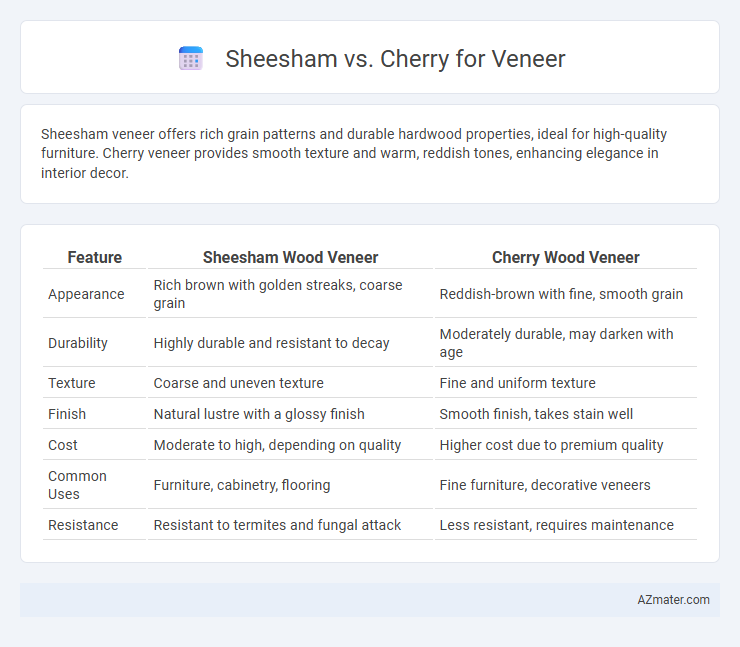Sheesham veneer offers rich grain patterns and durable hardwood properties, ideal for high-quality furniture. Cherry veneer provides smooth texture and warm, reddish tones, enhancing elegance in interior decor.
Table of Comparison
| Feature | Sheesham Wood Veneer | Cherry Wood Veneer |
|---|---|---|
| Appearance | Rich brown with golden streaks, coarse grain | Reddish-brown with fine, smooth grain |
| Durability | Highly durable and resistant to decay | Moderately durable, may darken with age |
| Texture | Coarse and uneven texture | Fine and uniform texture |
| Finish | Natural lustre with a glossy finish | Smooth finish, takes stain well |
| Cost | Moderate to high, depending on quality | Higher cost due to premium quality |
| Common Uses | Furniture, cabinetry, flooring | Fine furniture, decorative veneers |
| Resistance | Resistant to termites and fungal attack | Less resistant, requires maintenance |
Introduction to Sheesham and Cherry Veneer
Sheesham veneer, derived from the Dalbergia sissoo tree, is prized for its rich brown hues and distinct grain patterns, making it ideal for premium furniture and cabinetry. Cherry veneer, sourced from the American cherry tree, offers a warm reddish tone that deepens with age, favored for its smooth texture and elegant finish. Both veneers provide durability and aesthetic appeal, but Sheesham is known for its hardness while Cherry emphasizes a fine, uniform grain.
Botanical Background: Sheesham vs Cherry
Sheesham (Dalbergia sissoo) belongs to the Fabaceae family and is a deciduous hardwood native to the Indian subcontinent, known for its rich grain and durability, making it a popular choice for veneer. Cherry wood (Prunus serotina), part of the Rosaceae family, is a hardwood native to North America recognized for its fine, straight grain and warm reddish-brown hue that darkens over time. Both species offer distinct botanical characteristics influencing their texture, color, and suitability in veneer applications, with Sheesham providing a more pronounced grain pattern and Cherry offering smoother, more consistent coloration.
Grain Patterns and Aesthetic Appeal
Sheesham veneer features rich, dark brown hues with pronounced, wavy grain patterns that create a striking, natural texture ideal for traditional and rustic designs. Cherry veneer offers a smoother, finer grain with warm, reddish tones that deepen over time, enhancing its elegant and classic aesthetic appeal. Both woods bring unique visual characteristics, with Sheesham providing bold, dramatic patterns and Cherry offering a more subtle, refined finish.
Durability and Hardness Comparison
Sheesham veneer is known for its exceptional durability and hardness, making it highly resistant to scratches, dents, and wear over time. Cherry veneer, while also strong, is comparatively softer and more prone to surface damage under heavy use. The high density of Sheesham wood contributes to its superior hardness, providing a longer-lasting and more resilient veneer option than Cherry.
Color Variations and Aging Effects
Sheesham veneer exhibits rich, dark brown hues with golden or reddish streaks that deepen and mellow over time, enhancing its natural character and warmth. Cherry veneer displays a lighter, reddish-brown color that gradually darkens to a rich, reddish patina with exposure to light, lending a classic and elegant appearance. Aging effects on Sheesham intensify its grain contrast, while Cherry's aging process results in a smoother, satin-like finish, both contributing to unique aesthetic qualities in furniture and cabinetry.
Workability and Finishing Properties
Sheesham wood offers excellent workability with its medium density and straight grain, allowing for smooth cutting and sanding during veneer application. Cherry veneer, known for its fine, uniform texture and natural luster, provides superior finishing properties that enhance the richness and warmth of surfaces. Both woods deliver durable finishes, but Cherry's natural oils contribute to a slightly easier staining and polishing process compared to Sheesham.
Cost and Market Availability
Sheesham veneer generally offers a more affordable option compared to cherry veneer, making it popular for budget-conscious projects. Sheesham wood is widely available in markets, especially in Asian regions, whereas cherry veneer, prized for its rich color and fine grain, tends to be more costly and less abundant outside North America. The higher price and limited availability of cherry veneer reflect its premium status in furniture and cabinetry production.
Environmental Impact and Sustainability
Sheesham veneer comes from Dalbergia sissoo trees, which grow rapidly and are often harvested sustainably from managed plantations, resulting in a lower environmental footprint compared to cherry veneer derived from Prunus avium, whose slower growth rates can lead to increased deforestation risks. Sheesham's durable wood allows for long-lasting products, reducing the need for frequent replacements and minimizing waste, while cherry veneer, valued for its aesthetic appeal, typically requires more energy-intensive processing to achieve its smooth finish. Sustainable forestry certifications are more prevalent for Sheesham, promoting responsible harvesting practices that support biodiversity conservation and carbon sequestration better than many cherry sourcing operations.
Best Applications for Sheesham and Cherry Veneer
Sheesham veneer excels in furniture and cabinetry due to its durability, rich natural grain, and resistance to termites, making it ideal for high-traffic areas and antique-style pieces. Cherry veneer stands out for fine woodworking and decorative applications, offering a smooth texture with warm reddish hues that darken beautifully over time, perfect for elegant cabinetry and musical instruments. Both veneers suit distinct purposes, with Sheesham favored for rugged use and longevity, while Cherry is prized for aesthetic appeal and refined interiors.
Conclusion: Choosing the Right Veneer for Your Project
Sheesham veneer offers durability and a rich, natural grain ideal for traditional and rustic designs, while cherry veneer provides a smooth texture with warm reddish tones suited for elegant and contemporary styles. Consider project requirements such as strength, aesthetic preference, and budget when selecting between Sheesham and cherry veneers to ensure optimal results. Balancing hardness, color, and grain pattern is crucial for achieving the desired finish and longevity in your woodworking project.

Infographic: Sheesham vs Cherry for Veneer
 azmater.com
azmater.com